Are we alone in the universe? This age-old question continues to inspire astronomers to seek out habitable planets. The recent discovery of HD 20794 d, a Super-Earth orbiting a star just 19.7 light-years away, offers tantalizing insights into the potential for life beyond Earth.
What Makes HD 20794 d Unique?
A Super-Earth in a Habitable Zone
HD 20794 d is classified as a Super-Earth, a rocky planet larger than Earth but smaller than gas giants like Neptune. Measuring its mass and distance from its star revealed that it resides in the habitable zone—a region where liquid water could exist. Liquid water is a cornerstone for life as we know it, making this planet a compelling focus for astrobiology.
Unlike Earth’s circular orbit, HD 20794 d follows an elliptical trajectory that takes it in and out of the habitable zone. This means that parts of the planet’s surface could cycle between freezing and thawing phases. This variability raises intriguing questions about how life could adapt to such dynamic conditions.
Proximity: A Neighbor in Cosmic Terms
Located just 19.7 light-years from Earth, HD 20794 d orbits a G-type star similar to our Sun. Its proximity enhances its brightness and makes it an ideal candidate for observation with next-generation telescopes. Future missions, like those using the ANDES spectrograph on the Extremely Large Telescope (ELT), will focus on analyzing the planet’s atmosphere for potential biosignatures.
The Science Behind the Discovery
Detection Using Cutting-Edge Technology
Discovering HD 20794 d was no small feat. The team relied on over 20 years of data collected by state-of-the-art instruments such as ESPRESSO and HARPS. These advanced spectrographs measure the minute wobbles of stars caused by the gravitational pull of orbiting planets.
Adding to this precision was the YARARA algorithm, developed by researchers at the University of Geneva. This tool filters out noise from stellar activity, enabling astronomers to isolate planetary signals with unparalleled clarity. “For years, planetary signals were obscured by noise, making it difficult to confirm the planet’s existence,” said Michael Cretignier, one of the study’s co-authors.
A Closer Look at Its Orbit and Environment
The planet’s orbit is particularly fascinating. While HD 20794 d spends part of its time in the habitable zone, its elliptical path means it also ventures into colder regions. This oscillation presents a unique laboratory for understanding how planets might maintain water in various states over time.
By comparing HD 20794 d’s environment to Earth and Mars, researchers can refine their models of planetary habitability.
Why This Discovery Matters
Expanding Our Understanding of Habitability
HD 20794 d challenges traditional notions of habitability. While most habitable zone studies focus on planets with stable conditions, this Super-Earth forces scientists to consider more dynamic environments. If water exists on its surface, it could undergo a fascinating transformation—from ice to liquid—during each orbit.
A Platform for Future Research
One of the most exciting aspects of HD 20794 d is its accessibility for future observation. Its proximity and the brightness of its host star make it a prime candidate for detailed atmospheric studies. Instruments like the James Webb Space Telescope (JWST) and upcoming ground-based observatories will focus on detecting gases like oxygen, methane, and water vapor—key indicators of habitability.
This planet also serves as a testing ground for next-generation techniques in exoplanet exploration.
Broader Implications for Exoplanetology
A Growing Catalog of Exoplanets
HD 20794 d joins the ranks of over 7,000 exoplanets discovered in the past three decades. Its discovery highlights how far exoplanetology has come since the first exoplanet was identified in 1995. This field has transitioned from identifying planets to characterizing their potential for life, with HD 20794 d representing a significant step forward.
Interdisciplinary Collaboration
The study of HD 20794 d underscores the importance of interdisciplinary collaboration in astronomy. Detecting and analyzing exoplanets involves expertise in physics, chemistry, data science, and more. The Center for Life in the Universe (CVU) at the University of Geneva exemplifies this approach, bringing together researchers from diverse fields to study planetary habitability.
The Road Ahead
Challenges to Overcome
While HD 20794 d is a promising candidate for further study, confirming its habitability will require significant scientific milestones. Researchers must develop more precise instruments to analyze its atmosphere and surface conditions. They must also consider how factors like radiation and geological activity might influence its potential for life.
The Search for Biosignatures
One of the most exciting prospects for HD 20794 d is the potential to detect biosignatures—chemical markers that indicate the presence of life. By studying its atmosphere, astronomers hope to find evidence of gases like oxygen, which on Earth are closely linked to biological processes.
Conclusion: A New Frontier in Exoplanet Exploration
The discovery of HD 20794 d is more than just another addition to the catalog of exoplanets. It represents a new frontier in the search for habitable worlds and the quest to answer one of humanity’s oldest questions: Are we alone in the universe?
Reference:
N. Nari et al, Revisiting the multi-planetary system of the nearby star HD 20794. Confirmation of a low-mass planet in the habitable zone of a nearby G-dwarf, Astronomy & Astrophysics (2024). DOI: 10.1051/0004-6361/202451769



















